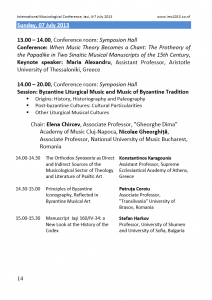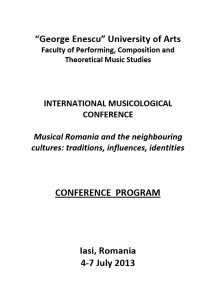Συνέδριο 5th International Musicological Conference [[i]]
Θεματική “Musical Romania and the neighbouring cultures: traditions, influences, identities”
Διοργάνωση Department of Theoretical Music Studies of “George Enescu” University of Arts Iaşi. IMS Regional Association for the Study of Music on the Balkans, Regional Association for the Balkan Countries of the International Musico-logical Society (IMS)
Τόπος, Χρόνος Iaşi, Romania, 04-07/07/2013 (“George Enescu” University of Arts Iaşi)
Ἀνακοίνωση “The Orthodox Synaxaria as direct and indirect sources of the independent science ‘Musicology of the Psaltic Art’ and its specific disciplines”
Περίληψη The Musicology of the Psaltic Art, as a relatively recent science, is still in that “precocious” situation, a typical feature of which -at least, in Greece- is the absence of clearly defined sectors of scientific research. The direct and primary need for investigation of the theoretical and musical sources, as well as for study and comprehension of the development of the notation, necessarily left “for a later day” the activity in other directions; directions like the Dida-ctic and Pedagogic of Psaltic Art, its Morphology and Analysis, its Anthropology and Psychology, its Comparative Musicology and other equally important ones. Among them, we think that the research on the Theology and Lite-rature of the Psaltic Art is a extremely important sector; through its conclusions one could go through all the theological teachings, the “theologiseis” of the Church Fathers about the Holy Psalmody, and at the same time through all the direct and indirect historical evidences of the Church and non-Church literature on the orthodox liturgical music. Aiming to an official definition of the sector of Theology and Literature of the Psaltic Art, the Orthodox Synaxaria is a “sine qua non” field for research, which comes out to be a very important source. The researcher, who has to keep in mind the conclusions of the theological sciences of Hagiology, Literature of Church Fathers, Theology of Orthodox Christian Worship and possibly some more, must simply keep a critical eye on the Synaxaria of all kinds (martyrologies, lives of Saints, ascetic texts etc), remembering that lots of evidence refer to the period the texts have been written and not to the period they speak about. Leaving this reservation aside, the texts of Synaxaria contain many interesting elements about Holy Psalmody, which can be epitomized in the following aspects.
– Psalmody as an uninterrupted, non-stop action of the Heaven’s Church of Angels and Saints, for endless glorification of the Most-Sacred Trinity God.
– Church Music as a guiding and saving vehicle inside the Orthodox Holy Worship, which has been cultivated and shaped by the enlightened “ἐν Πνεύματι Ἁγίῳ” Church Fathers, the sacred hymnographers, “melodoi” (hymnographers and also composers) and chanters.
– Psaltic as an Art, having close ties and being inseparably linked with the ritual elements of the Orthodox Worship, an Art which, however, went through gradual modification, reaching through the centuries high levels of artistry and virtuosity.
– Psalmody as a personal prayer, as a vehicle for prayer into the orthodox expe–rience of the Church in general, and of the individual faithful in particular.
– The non-Church music, the instruments, the secular songs, the dances and the relevant, the entertainments, the popular-folk feasts and festivals etc, are demonical tools and instruments of the devil, in his effort for “stealing” the spirit of man away from the Kingdom of the God.


